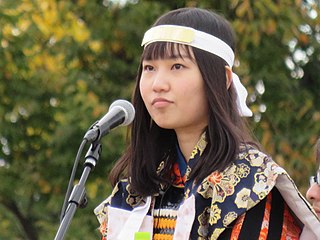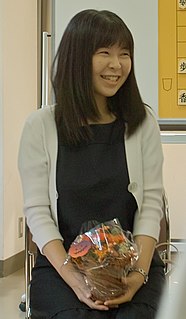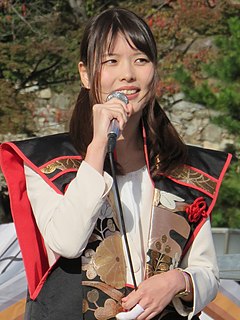 W
WHaruka Aikawa is a Japanese women's professional shogi player ranked 1-dan.
 W
WKazuo Azuma is a retired Japanese professional shogi player who achieved the rank of 8-dan. He is a former senior managing director of the Japan Shogi Association.
 W
WTetsuya Fujimori is a Japanese professional shogi player ranked 5-dan.
 W
WAya Fujita is a Japanese women's professional shogi player ranked 2-dan. She holds the record for being the youngest person at age 11 years 6 months to have ever been awarded women's professional status by the Japan Shogi Association.
 W
WKōhei Funae is a Japanese professional shogi player ranked 6-dan.
 W
WYūki Hasegawa is a Japanese women's professional shogi player ranked 2-dan.
 W
WMamoru Hatakeyama is a Japanese professional shogi player ranked 8-dan.
 W
WHexshogi is a shogi variant for two players created by George R. Dekle Sr. in 1986. The gameboard comprises 85 hexagonal cells. The game is in all respects the same as shogi, except that piece moves have been transfigured for the hexagonal board-cell geometry.
 W
WAi Iino is a Japanese women's professional shogi player ranked 1-dan.
 W
WAkira Inaba is a Japanese professional shogi player, ranked 8-dan. Inaba, together with Tetsurō Itodani, Masayuki Toyoshima and Akihiro Murata, is one of four Kansai-based young shogi professionals who are collectively referred to as the "Young Kansai Big Four".
 W
WSae Itō is a Japanese women's professional shogi player ranked 3-dan.
 W
WShinobu Iwane is a Japanese women's professional shogi player ranked 3-dan.
 W
WTatsunosuke Kanda is a deceased Japanese professional shogi player who achieved the rank of 8-dan and also 9-dan, which was an honorary rank, after death.
 W
WHiromitsu Kanki is a retired Japanese professional shogi player who achieved the rank of 7-dan.
 W
WKei Katō is a Japanese women's professional shogi player ranked 2-dan.
 W
WMomoko Katō is a Japanese women's professional shogi player ranked 3-dan. She is the current holder of the Seirei title and a former Women's Ōza and Jo-Ō titles.
 W
WYoshio Kimura was a Japanese professional shogi player who achieved the rank of 8-dan.
 W
WKensuke Kitahama is a Japanese professional shogi player, ranked 8-dan.
 W
WMadoka Kitao is a Japanese women's professional shogi player ranked 2-dan.
 W
WMasonic shogi is a shogi variant invented by George R. Dekle Sr. in 1987. The game is played on a modified shogi board whereby alternating ranks are indented to the right—resembling masonry brickwork. The moves of pieces are adapted to the new geometry; in other respects the game is the same as shogi.
 W
WChiho Murata is a Japanese women's professional shogi player ranked 2-dan.
 W
WIo Murota is a Japanese women's professional shogi player ranked 2-dan.
 W
WKunio Naitō is a retired Japanese professional shogi player who achieved the rank of 9-dan.
 W
WTakahiro Ōhashi is a Japanese professional shogi player ranked 6-dan.
 W
WMinami Sadamasu is a Japanese women's professional shogi player ranked 2-dan.
 W
WIn shogi, Sakata Opposing Rook is an Opposing Rook opening.
 W
WShin'ichi Satō is a Japanese professional shogi player ranked 5-dan.
 W
WSaki Satomi is a Japanese women's professional shogi player ranked 1-dan. Her older sister Kana is also a women's professional shogi player.
 W
WSpace shogi is a three-dimensional shogi variant invented by George R. Dekle Sr. in 1987. The gamespace comprises nine 9×9 shogi boards stacked vertically. Each player controls a standard set of shogi pieces.
 W
WMasataka Sugimoto is a Japanese professional shogi player ranked 8-dan. He is a former non-executive director of the Japan Shogi Association.
 W
WKanna Suzuki is a Japanese women's professional shogi player ranked 3-dan.
 W
WAiko Takahama is a Japanese women's professional shogi player ranked 1-kyū.
 W
WRei Takedomi is a Japanese women's professional shogi player ranked 1-dan.
 W
WBeni Takemata is a female announcer for Fuji TV. She is a former Japanese women's professional shogi player who was ranked 1-dan. In December 2018, she announced her intention to retire from professional shogi and leave the Japan Shogi Association at the end of March 2019 to pursue other opportunities as well as to focus on her studies in political science and economics at Waseda University. She is formerly managed by Watanabe Entertainment as one of their "Intellectual Tarentos", appearing on Japanese variety shows and making personal appearances. On April 2021, she joined Fuji TV as announcer.
 W
WTrishogi is a shogi variant for two players created by George R. Dekle Sr. in 1987. The gameboard comprises 9×10 interlocking triangular cells. The game is in all respects the same as shogi, except that piece moves have been transfigured for the triangular board-cell geometry.
 W
WMasao Tsukada was a Japanese professional shogi player who achieved the rank of 8-dan and also 10-dan, which is an honorary rank, after death. He is a former Meijin and Ninth Dan title holder.
 W
WNanako Wakita is a Japanese women's professional shogi player ranked 1-dan.
 W
WEmina Yamaguchi is a Japanese women's professional shogi player ranked 1-kyū.
 W
WEriko Yamaguchi is a Japanese women's professional shogi player ranked 2-dan.
 W
WShin'ya Yamamoto is a Japanese professional shogi player ranked 6-dan.
 W
WTakayuki Yamasaki is a Japanese professional shogi player ranked 8-dan.
 W
WRieko Yauchi is a Japanese women's professional shogi player ranked 5-dan. She is a former Women's Meijin, Ōi and Jo-Ō title holder.